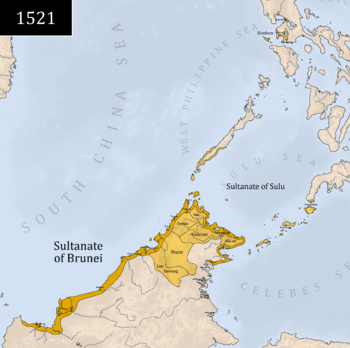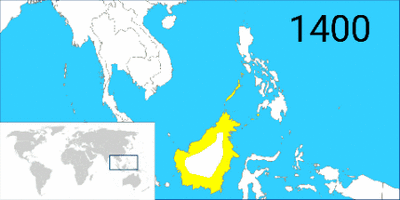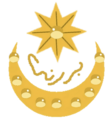Bruneian Sultanate (1368–1888) facts for kids
Quick facts for kids
Sultanate of Brunei
كسلطانن بروني (Jawi)
Kesultanan Brunei (Rumi) |
|||||||||||||||||||||||||
|---|---|---|---|---|---|---|---|---|---|---|---|---|---|---|---|---|---|---|---|---|---|---|---|---|---|
| 1363/68–1888 or 1906 | |||||||||||||||||||||||||

The maximum territorial extent of the Bruneian Empire (yellow) with its vassals (light yellow) in 1521.
|
|||||||||||||||||||||||||
| Status |
|
||||||||||||||||||||||||
| Capital |
|
||||||||||||||||||||||||
| Common languages | Brunei Malay, Old Malay, Old Tagalog, Kapampangan, Arabic and Bornean languages | ||||||||||||||||||||||||
| Religion | Sunni Islam | ||||||||||||||||||||||||
| Demonym(s) | Bruneian | ||||||||||||||||||||||||
| Government | Monarchy | ||||||||||||||||||||||||
| Sultans | |||||||||||||||||||||||||
|
• 1363/68–1402
|
Sultan Muhammad Shah | ||||||||||||||||||||||||
|
• 1425–1432
|
Sharif Ali | ||||||||||||||||||||||||
|
• 1485–1524
|
Bolkiah | ||||||||||||||||||||||||
| History | |||||||||||||||||||||||||
|
• Establishment of the Sultanate
|
1363/68 | ||||||||||||||||||||||||
|
• Became a British protectorate
|
1888 or 1906 | ||||||||||||||||||||||||
| Currency | Barter, Cowrie, Piloncitos, and later Brunei pitis | ||||||||||||||||||||||||
|
|||||||||||||||||||||||||
| Today part of | |||||||||||||||||||||||||
The Sultanate of Brunei (also known as the Brunei Empire) was a powerful Malay kingdom. It was located on the northern coast of Borneo in Southeast Asia. Brunei became an independent state around the 15th century.
It grew a lot after the fall of Malacca to the Portuguese. The Sultanate then controlled large parts of Borneo and the Philippines. However, its power started to shrink in the 17th and 18th centuries. In the 19th century, it became a British protectorate, meaning Britain protected it.
Contents
Learning About Brunei's Past
It is hard to know everything about the early Sultanate of Brunei. This is because there are not many old records from Brunei itself. Historians often use old Chinese writings to learn about Brunei's early days.
Some Chinese texts mention a place called Boni. This likely refers to Western Borneo. Another name, Poli, might also refer to Brunei.
History of the Sultanate of Brunei
Brunei Before the Sultanate
In the 14th century, Brunei was not yet a strong independent state. It was a vassal state of Java, meaning it was under the control of the Majapahit kingdom. A Javanese book from 1365, called Nagarakretagama, says that Brunei had to send 40 katis of camphor to Majapahit every year as a tribute.
After Majapahit attacked Brunei, some of Brunei's own territories in the Philippines rebelled. The kingdom of Sulu, which used to be under Brunei's control, even attacked and robbed Brunei. Brunei was so weak that the Majapahit fleet had to rescue it.
How Brunei Grew Stronger
After the city of Malacca was taken by the Portuguese in 1511, Portuguese traders started visiting Brunei often. By 1530, they described Brunei's capital as having a stone wall around it.
During the time of Bolkiah, who was the fifth sultan, Brunei became very powerful. The Sultanate controlled the coastal areas of northwest Borneo. This includes what is now Brunei, Sarawak, and Sabah. Its influence also reached Seludong (which is now Manila) and the Sulu Archipelago. This area includes parts of the island of Mindanao.
In the 16th century, Brunei's power spread even further. It reached the Kapuas River delta in West Kalimantan. The Malay Sultanate of Sambas and the Sultanate of Sulu had family ties with Brunei's royal family. Even the Muslim leaders of Manila, like Rajah Matanda, were connected to the Brunei Sultanate.
Many Malay sultans in Borneo, like those from Pontianak and Banjarmasin, looked up to the Sultan of Brunei as their leader. The exact relationship between Brunei and these other sultanates is still studied. It could have been a vassal state, an alliance, or just a formal connection.
The growth of Malacca as a major trading center helped spread its culture. Malay became the main language for trade in Southeast Asia. Many places adopted Islamic Malay customs and ways of governing.
Around 1500, Sultan Bolkiah led a successful trip north. He wanted to break Tondo’s control over trade with China. He then set up Maynila (Selurong) across the Pasig delta. This new city was ruled by his family as a satellite state.
Brunei's influence also reached other areas around Manila Bay. This included present-day Batangas and coastal Mindoro. This happened through more trade and political connections. Many Kapampangan and Tagalog people lived in Brunei and Malacca. They worked as traders, sailors, shipbuilders, and more.
The Decline of Brunei
The Sultanate of Sulu grew stronger as Brunei faced problems. Disagreements among Brunei's own leaders also weakened the Sultanate. Brunei eventually lost control over many of its territories. These areas then became ruled by local chiefs.
By the late 17th century, Brunei began to decline. This was due to internal conflicts over who would be the next sultan. Also, European powers started to expand their control in the region. The Spanish took over parts of the Philippines. The Dutch gained control in southern Borneo. The British took Labuan, Sarawak, and North Borneo. By 1725, Brunei had lost many of its trade routes to the Sultanate of Sulu.
In 1888, Sultan Hashim Jalilul Alam Aqamaddin asked the British for help. He wanted them to stop other powers from taking more land. In the same year, the British signed a "Treaty of Protection." This made Brunei a British protectorate. Brunei remained a British protectorate until 1984, when it became fully independent.
How Brunei Was Governed
The Sultanate had three main ways of owning land. These were called kerajaan (land owned by the crown or royal family), kuripan (land for officials), and tulin (private land passed down through families).
Images for kids






